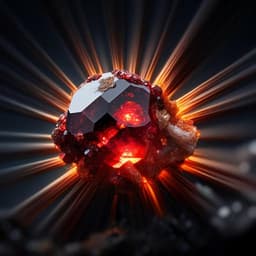Introduction
The urgent need to transition from fossil fuels to renewable energy sources like solar and wind power necessitates the development of efficient and sustainable energy storage solutions. Supercapacitors, while having lower energy density than batteries, offer superior power density and cycling stability, making them ideal for applications requiring rapid charging and high-rate cycling. Electrochemical double-layer capacitors (EDLCs) are the most common type of supercapacitors, often utilizing carbon-based materials. However, to improve their energy storage capacity, redox-active materials like quinones can be incorporated to enhance pseudocapacitance. Quinones, present in abundant biosourced materials such as melanin and tannins, offer a promising sustainable alternative to traditional electrode materials. However, challenges remain, particularly the high contact resistance at the quinone/carbon interface, leading to poor rate response and limited cycling life. This study aims to address this challenge by engineering the interface between the biosourced quinone materials and the carbon substrate to achieve high-performance, environmentally benign electrochemical capacitors.
Literature Review
Previous research has explored various quinone-based materials for supercapacitors, demonstrating promising results. Polyanthraquinone/carbon electrodes have shown specific capacitance up to 650 F g⁻¹ but with limited cycling stability. Polydopamine-based electrodes exhibited high capacitance but relatively low cycling stability. Other studies with carbonized chitosan, pyrolyzed benzoquinone-amine, and perylene diimide-based electrodes showed varying levels of success in terms of capacitance and cycling performance. However, a common limitation is the high contact resistance at the quinone/carbon interface, impacting rate capability and longevity. This prior work highlights the potential of biosourced quinones but also the need for effective interface engineering to overcome the limitations of high contact resistance and achieve improved device performance.
Methodology
The study utilized carbon paper (CP) as the base electrode material, which was chemically treated using a two-step process involving mixed acid treatment (H₂SO₄/HNO₃) and (NH₄)₂HPO₄ solution to create treated carbon paper (TCP). This treatment aimed to enhance surface area, porosity, and wettability. Sepia melanin was extracted from cuttlefish ink, while catechin (Ctn) and tannic acid (TA) were purchased commercially. Electrodes were prepared by solution-processing the quinone materials onto the CP and TCP substrates. Scanning electron microscopy (SEM), energy-dispersive X-ray spectroscopy (EDX), X-ray diffraction (XRD), Raman spectroscopy, and X-ray photoelectron spectroscopy (XPS) were used to characterize the morphology, elemental composition, and surface chemistry of the electrodes. Electrochemical characterization, including cyclic voltammetry (CV), galvanostatic charge-discharge (GCD), and electrochemical impedance spectroscopy (EIS), was performed in 0.5 M Na₂SO₄ aqueous electrolyte using both three-electrode and symmetric two-electrode configurations. The electrochemical performance metrics such as capacitance, cycling stability, coulombic efficiency, energy density, and power density were evaluated.
Key Findings
The chemical treatment of carbon paper significantly improved its electrochemical properties. The TCP exhibited a much larger surface area (43.0 m² g⁻¹) and pore volume (2.0 × 10⁻³ cm³ g⁻¹) compared to the untreated CP (0.4 m² g⁻¹ and 6 × 10⁻⁴ cm³ g⁻¹), along with enhanced wettability. The EDX mapping revealed the presence of O, N, S, and P on TCP, contributing to its improved electrochemical performance. Sepia melanin on TCP showed a remarkably high areal capacitance of 1355 mF cm⁻² (452 F g⁻¹), while Ctn/TA on TCP exhibited a capacitance of 898 mF cm⁻² (300 F g⁻¹). Both materials demonstrated excellent cycling stability with 100% capacitance retention and coulombic efficiency over 50,000 cycles (Sepia melanin) and 10,000 cycles (Ctn/TA) at 150 mA cm⁻². The symmetric supercapacitors based on these materials achieved impressive maximum energy densities of 0.56 mWh cm⁻² (20 Wh kg⁻¹) for Sepia melanin and 0.65 mWh cm⁻² (23 Wh kg⁻¹) for Ctn/TA, and maximum power densities of 1274 mW cm⁻² (46 kW kg⁻¹) and 727 mW cm⁻² (26 kW kg⁻¹), respectively. The addition of conductive additives did not improve the performance, highlighting the efficacy of the interface engineering.
Discussion
The significantly enhanced electrochemical performance of the biosourced quinone electrodes on TCP can be attributed to the synergistic effects of increased surface area, optimized porosity, improved electrolyte wettability, and the introduction of Faradaic processes from heteroatom doping on the carbon surface. The high capacitance values achieved are comparable to or surpass many previously reported results for organic electrode materials, especially considering the absence of conductive additives. The excellent cycling stability demonstrates the robustness of the engineered interface and the inherent stability of the biosourced quinones in aqueous electrolyte. These findings demonstrate a significant advancement in the field of sustainable energy storage by achieving high-performance supercapacitors using readily available, environmentally benign materials.
Conclusion
This study successfully demonstrates high-performance environmentally benign electrochemical capacitors using biosourced quinones. Interface engineering through chemical treatment of carbon paper is crucial for maximizing the performance of these materials. The remarkable capacitance, cycling stability, and energy/power densities achieved with Sepia melanin and Ctn/TA on TCP represent a substantial advancement towards sustainable energy storage. Future research could explore other biosourced quinone sources, optimize the chemical treatment of the carbon substrate, and investigate different electrolyte systems for further performance enhancement.
Limitations
The study focused on two specific biosourced quinones, and further investigation with a broader range of materials is warranted. The long-term stability of the devices over extremely long cycle life (beyond 50,000 or 10,000 cycles) could be further investigated. While the aqueous electrolyte is environmentally benign, exploring alternative electrolytes could potentially lead to higher voltage windows and energy densities. The mass loading of active material was relatively high, and future work could examine lower loadings to improve gravimetric performance.
Related Publications
Explore these studies to deepen your understanding of the subject.







